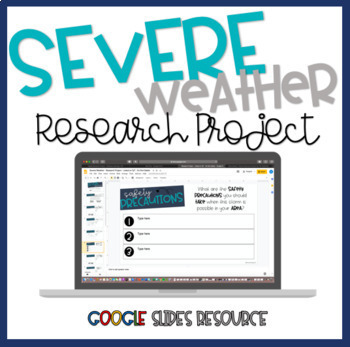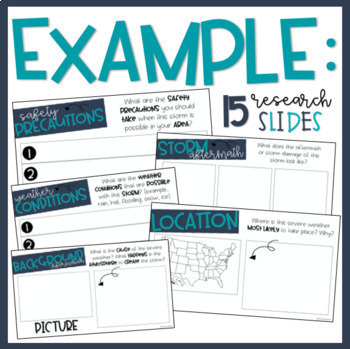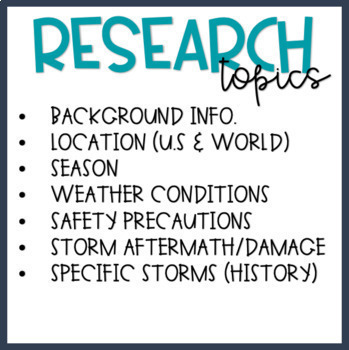Severe Weather | Digital Research Project | Distance Learning
- Google Slides™

What educators are saying
Description
Severe Weather | Hurricanes, Tornadoes, Blizzards, or Thunderstorms Research Project
This Google Slides digital learning product is the perfect way to implement technology into your classroom. Students will choose from four types of severe weather; tornadoes, hurricanes, blizzards and thunderstorms. Students will walk through the Google Slides presentation that prompts them with questions to research- Think of this as "guided research". Students are researching, but are being prompted on what exactly to research. Each slide is complete with boxes to include photographs and easy to type text boxes.
Included in TPT purchase:
- 15 Research Slides
What are the topics covered?
- Hurricanes
- Tornadoes
- Blizzards
- Thunderstorms
What are students researching about their type of severe weather?
- What is the cause of the severe weather? What happens in the atmosphere to create the storm?
- Where is this severe weather most likely to take place? Why?
- Do these types of storms take place in other parts of the world? Why or why not?
- What are the safety precautions you should take when this storm is possible in your area?
- What is the season of this storm? Why is this storm more likely during this season?
- How is this storm categorized? What do the categories mean?
- What are the weather conditions that are possible with this storm? (example, rain, hail, flooding, snow, ice)
- What does the aftermath or storm damage of this storm look like?
- Is there a storm that has happened in the past that was extremely rare? Or caused significant damage?
- What websites or books did you use for your research information? List them here.
Did you know you can receive TPT credits for leaving feedback? How it Works:
Earn TpT Credits for purchases on TpT. You get one TpT Credit for every $ you spend on TpT. Thing is, you only get the Credits after you Provide Feedback -- both a fair rating and a fair comment -- on the items that you purchase. We will round up for you, too! If you provide fair feedback on a $4.75 item, you will earn 5 credits. Every 100 Credits is worth $5 that you can apply towards future TpT purchases, but there is no need to wait until you have 100 to redeem them. 50 credits is worth $2.50, for example.





